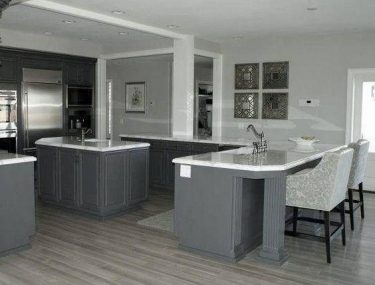Are Kitchen Islands a Thing of the Past? The Experts Weigh In
 We’ve all heard the age-old saying “the kitchen is the heart of the home,” but are islands—the standalone workstation that often doubles as a place to sit—causing the vital organ to become a bit congested these days? Though kitchen islands provide much-appreciated extra space for food preparation and a less formal alternative to a traditional dining table, they may be a bigger nuisance than we care to admit. So we chatted with three design experts to get their opinion on the matter.
We’ve all heard the age-old saying “the kitchen is the heart of the home,” but are islands—the standalone workstation that often doubles as a place to sit—causing the vital organ to become a bit congested these days? Though kitchen islands provide much-appreciated extra space for food preparation and a less formal alternative to a traditional dining table, they may be a bigger nuisance than we care to admit. So we chatted with three design experts to get their opinion on the matter.
First, let’s point out the obvious benefits of kitchen islands: “Islands with bar stools allow for additional casual seating options in the kitchen,” explains Mimi Meacham, principal designer and founder of Houston-based Marian Louise Designs. “Whether it’s breakfast for the kids or girlfriends chatting while you’re cooking, kitchen islands create a defined space in an open concept space. They add plentiful counter space for prepping meals, packing lunches, and decorating cookies.”
Of course, the practical benefits of a kitchen island date back to the early 19th century when wealthy European families (think Downton Abbey‘s Crawleys) installed a worktable in front of the hearth or stove for the servants to prepare meals. Back then, the families rarely visited the kitchen, making the island a practicality reserved only for the staff. These days, of course, they’re a hallmark in plenty of spacious kitchens where plenty of families actually spend most of their time. Is that a good thing, though?
“I believe they’ll continue to be integrated into kitchens for years to come, but their functionality might shift,” Carisha Swanson, House Beautiful‘s longtime market director, says, “For instance, the island may start trending—and may have already started trending—back to being fully functional with no seating.” They may simply become a place for extra storage in large kitchens or a hiding spot for under-counter appliances, including refrigerator drawers and dishwashers.
Regardless of how a family uses the kitchen island—for storage, seating, or meal prep—there are a few things to note before making such an investment. Sarah Blank, principal designer and owner of her eponymous Connecticut-based kitchen and bath design firm, says, “To have an island in your kitchen, you need to consider the following: A minimum of 42- to 45-inch walkways all around.” Then, there’s the overhang. “Remember, when figuring your walkway dimensions, take into consideration the countertop overhang. If there are stools on an island, you must consider leaving more space. (A minimum of 48 inches).” In other words, your kitchen needs to be on the bigger side and feature an open layout to properly support a useful kitchen island. That said, “There has never been a downside to having an island, provided it is adequately designed,” Blank adds.
Even then, however, kitchen islands may not be the best idea—especially if your family uses mealtimes to connect. Swanson explains, “Sitting side-by-side with no one across from you might be better reserved for a restaurant bar scene than home life.” She has a point: There’s a reason dining tables are surrounded by chairs. It’s so everyone sitting can actually see one another. Before investing in a kitchen island, ask yourself this: “Does my kitchen really need an island, or am I just filling up space?”
The verdict: Skip the island. Yes, they offer a significant amount of space to chop, stir, and dice, but if your kitchen is on the smaller side, they may take up more room than they’re offering. Plus, if you’re using the island as seating, climbing in and out of bar stools every day may lose its luster eventually. Swanson admits, “All in all, I think the main thing for anyone considering a remodel is to really evaluate their needs.”
Source: House Beautiful















 Accessibility
Accessibility